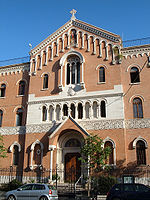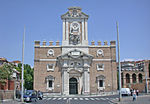Gardens of Sallust
Ancient gardens in RomeBuildings and structures completed in the 1st century BCPleasure gardensRome R. XVII Sallustiano

The Gardens of Sallust (Latin: Horti Sallustiani) was an ancient Roman estate including a landscaped pleasure garden developed by the historian Sallust in the 1st century BC. It occupied a large area in the northeastern sector of Rome, in what would become Region VI, between the Pincian and Quirinal hills, near the Via Salaria and later Porta Salaria. The modern rione is now known as Sallustiano.
Excerpt from the Wikipedia article Gardens of Sallust (License: CC BY-SA 3.0, Authors, Images).Gardens of Sallust
Piazza Sallustio, Rome Municipio Roma I
Geographical coordinates (GPS) Address Website External links Nearby Places Show on map
Geographical coordinates (GPS)
| Latitude | Longitude |
|---|---|
| N 41.908083333333 ° | E 12.496916666667 ° |
Address
Horti Sallustiani
Piazza Sallustio
00198 Rome, Municipio Roma I
Lazio, Italy
Open on Google Maps










